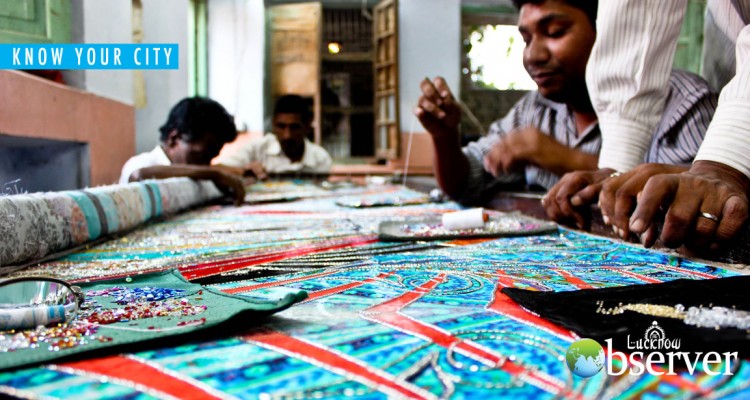The Legacy of Threads
Akansha
Zardozi is a Persian word that means sewing with gold string, where Zar meaning Gold and Dozi meaning Embroidery. Zardozi – the magnificent metallic embellishment of India – dates back to ancient times. It finds mention in Vedic literature, the Ramayana and the Mahabharata, and all accounts of the Sultanate period. The country, from very early times, was known for the use of gold embroidery on a variety of objects including furnishings, trappings, parasols, and equestrian ornaments.
The more aesthetic and evolved embroideries were used on court costumes and especially on accessories such as shoes. The historical accounts of this craft are shrouded in romantic stories and no accurate data is available. Zardozi attained its summit in the 17th century, under the patronage of Mughal Emperor Akbar. It was during Aurangzeb’s reign when the art spread to other parts of the country wherein Lucknow became a major centre. Since then Zardozi has remained Lucknow’s imperial art. The Zardozi work in Lucknow can be attributed to delicate intricacy, elegance and inherent beauty, all emerging from the zeal of the local artisans.
Zardozi became equally popular with the wealthy Hindu, Muslim and European elite downs the ages. The craftspeople, who worked with this medium, setting seed pearls and precious stones with fine gold and silver wire, were known as zardos workers. The royal patronage stopped and this led to the decline of the craft. Since the cost was high and raw materials quite rare, craftsmen could not carry on with the embroidery on their own. Today several families in Varanasi, Agra, Lucknow, Rampur, Bareilly and Farukkabad have revived this old craft to supply exquisite zari embroidered bridal outfits and shalwar- kameez to boutiques around the country.
In recent years, zardozi has seen a renewed interest in Hyderabad. Zardozi is also combined with Dabka work and is originally said to be from Lucknow. Traditionally, only men did zardozi work, and mostly in Lucknow and Kolkata but this no longer holds true. In Hyderabad, a growing zardozi centre, 10-15 per cent of the thousands of zardozi workers in Hyderabad are women. Done with metal wire and metal pieces or sequins on velvet, satin and heavy silk bases, zardozi is one of the most famous and elaborate techniques in metal embroidery. The original embroidery of zardozi was done with pure silver wires coated with real gold, and was known as Kalabatun.
Though silver and gold wires have now been replaced with synthetic threads, the art remains the same. The use of metal embroidery in Indian textiles and costumes, especially those used for ritual or ceremonial purposes, demonstrates the importance of gold and silver within the culture. Of all the crafts of the country, zardozi seems to have flourished and survived to the present day like few others. Metal ingots are melted and pressed through perforated steel sheets, to be converted into wires. They are then hammered to the required thinness. Plain wire is called badla, and when wound round a thread, it is called kasav. Smaller spangles are called sitara, and tiny dots made of badla are called mukaish. The original zardozi thread was made from an alloy of silver and gold. The wire that came out of the furnace, although containing a lot of silver in it, glittered like gold. This flattened wire was then twisted around silk threads to form the spring like zardozi. Zardozi uses dabka (a spring type of thread), kora, katori, tikena, and sitara (sequins) and also glass and plastic beads at times. Heavy and grand to look at, garments made with zardozi embroidery can weigh a lot in terms of pounds and kilos. Zardozi is sheer magic of nimble fingers and imaginative designs.
Earlier the designs used to be very Mughal in nature, comprising of floral and leaf patterns derived from that era. With modern influences, the patterns have changed. More and more geometric designs are used but flowers, petals and leaves still find their place. The design is first traced on a tracing sheet and holes are made along the traced pattern using a needle. The fabric on, which the embroidery is to be done, is placed on a flat table and the tracing sheet is placed in position. A solution of kerosene and Robin Blue is made. A wad of cloth is dipped into this solution and wiped against the tracing so that the ink seeps through the holes to trace the design on to the fabric. This is then sent to the embroidery workers. The fabric to be embroidered is stretched taut over a frame called the adda. This concept has evolved from a knockdown camp bed called the khatia used in rural areas.
The adda follows the assembly and tightening principles of the khatia, and gives the cloth a uniform tension. It consists of four wooden spars (sometimes, bamboo is used for the end members) resting on wooden posts. The frame can be made to fit any size of fabric. The artisan sits on the floor behind the wooden frame working on the piece of cloth. The frame itself is quite large, and can comfortably accommodate five to seven artisans working together on the pre- traced designs. A simple needle or a crochet like hook fixed to a wooden stick called the ari are used for the embroidery. The ari greatly enhances the speed of the work, as it enables the artisan to pass the threads both above and below the fabric.
The zari has its disadvantages, though. One tug at a loose thread can spell disaster to the entire design as it can unravel in a matter of minutes. The needle and thread method is far more dependable, but is very time and labor consuming, and hence far more expensive. All kinds of combinations are used to add to the grandeur of zardozi. A little bit of thread work here or a few sequins or semi precious stones added there, can make the fabric appealing while giving it a unique exclusivity.
By the end of the Mughal era, the art declined because of its high cost and the lack of precious metals for the purpose of embroidery. It was again revived in the 20th century. Today, like everything else, zardozi too has its limitations, being sold in the market at a much cheaper cost, made out of copper and brass wires plated with gold. The latest additions are colored zardozi with a plastic base. Far more pocket friendly, this new zardozi lasts longer and is lighter to wear. At times the base fabrics have plastic replacements in place of what was formerly pure gold and the motifs are so far removed from the original, that the product does not resemble what had at one time bedazzled visitors to the royal courts of India. The days of using real gold and silver thread are now history.
What one can get, however, is synthetic or ‘tested’ zari embroidery. The richness of gold may no longer grace the work of zardozi craftsman, but the glitter and glamour endures – hopefully it will for years to come. Zardozi is as tenacious as the wires the craftsmen work with. It is estimated by the Textile Ministry that there are more than 10,000 micro and small enterprises, which are involved in making zardozi products in this region. The world-renowned Lucknow Zardozi has recently been accorded the Geographical Indication (GI) under the Geographical Indication Registry (GIR). Lucknow still remains among the oldest and finest centers for Zardozi.
Writer is a student, an aspiring painter & calligrapher
(Published in The Lucknow Observer, Volume 1 Issue 11, Dated 05 February 2015)


